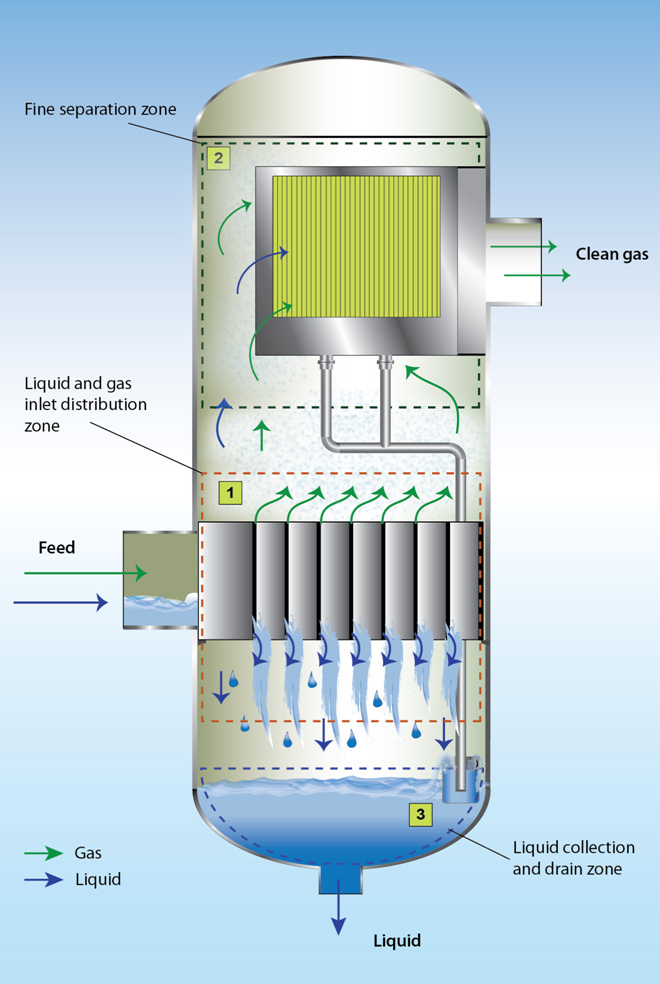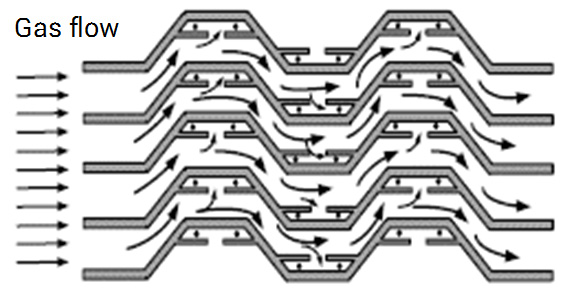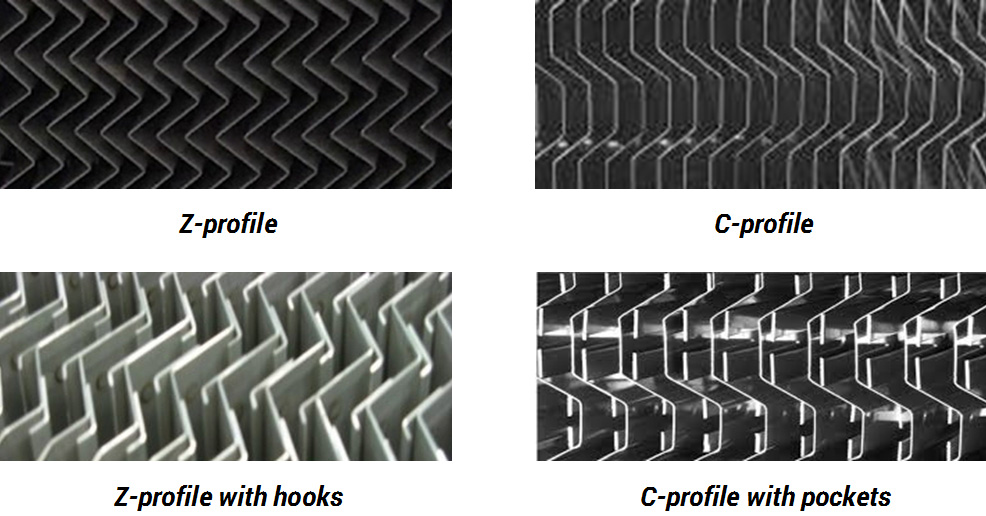Mist Eliminators
THE BEST PARTNER HANBIT SOLTECH
• Mechanical Action
• Condensation
• Chemical Reaction
Liquid droplets can be formed by contact between gas and liquid in a mass transfer operation, or by condensation on the surface of heat exchanger. Droplets can be also formed from gas phase reactions which yield a liquid product. The liquid droplet size depends on the mechanism which entrainment can be generated as shown in the chart. Droplet size is essential for a proper mist eliminator design.
✔ Avoid carry over of liquid which could cause damage to downstream equipment, eg. by accumulated liquid slugging into a reciprocating compressor.
✔ Avoid carry over of specific components in the entrained liquid :
• product contaminants (eg. colored molecules)
• process contaminants (eg. which would poison catalyst in a downstream process)
• high value circulating process materials (eg. selective solvents, or catalyst solutions)
• solids in solution which polymerize (these may cause blockage in downstream equipment)
Removal of the specific components may be required to a very high efficiency, but carry over of liquid which does not contain these components may well be quite acceptable.
Protect downstream equipment
Mist eliminators protect downstream corrosion and damage to equipment such as compressors, blowers, driers, and turbines.Improve product purity
Mist eliminators improve the purity of overhead gas and side draw-off liquid in packed and trayed towers.Prevent contamination
Mist eliminators prevent the poisoning of expensive downstream catalysts and potential contamination problems.Increase recovery of valuable chemicals
Mist eliminators reduce losses of expensive chemicals such as glycols, amines, or solvents in absorption and regeneration towers.Reduce environmental pollution
Mist eliminators help reduce droplet emissions from acid plants to environmentally acceptable levels.Mesh Pad Mist Eliminators
Mesh pad mist eliminators are fabricated from fine wire which is crimped to form a double layer. This double layer material is then either rolled into a cylinder or layered to form the desired thickness of mesh pad. This arrangement provides free volumes of 90 to 99% with surface areas from 160 to 2000 m2/m3. As the vapor carrying the entrained liquid passes through the mesh, the liquid droplets impinge and adhere to the fine wire, coalesce, and drain by gravity.
• Easy to install in all process equipment
• Most cost-effective solution
• Nickel Alloys
• Titanium
• Aluminum
• Copper
• Polypropylene
• Fluoroplastics
Inertial Impaction occurs when the droplets have sufficient momentum and cannot follow the gas stream. Direct Interception occurs if the gas streamlines carrying the droplets are close to the wire for contact. Diffusion results when the droplet mass is very low and the droplets are deposited by Brownian motion on the wire surface.
Droplets larger than 1 micron are removed by impaction and interception, whereas droplets smaller than 1 micron are removed mainly by diffusion.
※ If the entire table is not visible, you can scroll the table left and right to check the entire table..
| Density, kg/㎥ | Surface Area, ㎡/㎥ | Voids, % | Hanbit Soltech | Equivalent Mesh Style | ||
|---|---|---|---|---|---|---|
| YORK | UOP | AMACS | ||||
| Metal mesh mist eliminators | ||||||
| 80 | 157 | 99.0 | HST-80 | 931 (708) | B | 7CA |
| 120 | 210 | 98.5 | HST-120 | 422 | ||
| 128 | 459 | 98.4 | HST-128 | 326 (194) | 3BF | |
| 144 | 282 | 98.2 | HST-144 | 431 (172) | A | 4CA |
| 193 | 375 | 97.5 | HST-193 | 421 (709) | C | 4BA |
| 220 | 905 | 97.2 | HST-220 | |||
| 432 | 2000 | 94.6 | HST-432 | 333 | X-100 | |
| Plastic mesh mist eliminators | ||||||
| 42 | 360 | 97.0 | HST-193P | F | ||
| 64 | 430 | 96.5 | HST-300T | 221 | D | 8T |
Vane Pack Mist Eliminators
Vane pack mist eliminators are high capacity droplet separators consisting of plates with parallel chevron profiles. These mist eliminators are generally not efficient for droplets smaller than about 20 microns, but they are suitable for applications with high vapor velocities, low available pressure drop, viscous liquids or a significant risk of fouling due to solid particles. The vane packs are classified into various styles depending on the direction of the gas flow and the features of the vane profile.
• Ideal for viscous liquids or fouling service
• Mechanically durable construction
• Carbon Steel
• Nickel Alloys
• Titanium
• Polypropylene
• Fluoroplastics
The vane profiles allow the gas to change direction several times from inlet to outlet. The changes in gas flow direction combined with inertia of the entrained liquid droplets cause impingement of the droplets onto the plate surface. The liquid droplets impinge and adhere to the surface at each curve, eventually coalescing into larger droplets which then drain by gravity.
With vertical flow, collected liquid drips from the bottom of the vane and falls through the rising gas. With horizontal flow, a drainage path is required at the bottom of the vane.
※ If the entire table is not visible, you can scroll the table left and right to check the entire table..
| Profile | Z - profile | C - profile | Z – profile w/ hooks | C – profile w/ pockets |
|---|---|---|---|---|
| Flow Direction | Vertical | Vertical or Horizontal | Horizontal | Vertical or Horizontal |
| K-values | 0.50 ft/s | 0.55-0.75 ft/s | 0.65 ft/s | 1.00 ft/s |
| Efficiency | Medium | Medium | Medium - High | High |
| Pressure drop | Low | Low | Low | Moderate |
| Applications | General use Low cost | General use | Horizontal scrubbers | Debottlenecking |





